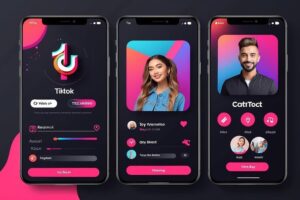Mobile application development refers to the set of processes and procedures involved in creating software for small, wireless computing devices such as smartphones and handheld devices.
Similar to web application development, mobile application development has its roots in traditional software development. However, a key distinction is that mobile apps are often crafted to leverage the distinctive features of a particular mobile device. For instance, a gaming app might be designed to utilize the iPhone’s accelerometer, while a mobile health app could make use of a smartwatch’s temperature sensor.
Currently, the dominant mobile platforms are Apple’s iOS and Google’s Android. Apple devices come preloaded with essential applications and the Apple App Store, while Android devices offer a similar setup with the Google Play Store.
Types of mobile applications
In the early stages of mobile app development, ensuring optimal performance across devices often required native development, meaning code had to be tailored for each device’s specific processor. However, in the present, the majority of mobile applications are designed to be device-agnostic.
Previously, creating cross-platform apps that run on multiple operating systems meant minimal code could be reused from the initial development. Modern cross-platform tools, utilizing common languages like C# and JavaScript, enable code sharing across projects, especially with the integration of application lifecycle management tools such as Jenkins. This allows developers to use a single codebase for Apple iOS, Google Android, and progressive web apps (PWAs). PWAs leverage native mobile device features without the need for users to visit an app store, make purchases, or download local software, offering an immediate browser-based access alternative.
Just like YouTube videos, PWA content is progressively downloaded, enhancing the user experience compared to traditional responsive design websites. Progressive web apps are also referred to as instant mobile apps.
Before embarking on app development, it’s essential to determine the type of app you intend to create. Here’s a breakdown of various mobile app development technologies:
- Native applications: built using integrated development environments (IDEs) and languages specific to mobile OSes such as Apple iOS or Google Android. While allowing for customization of features, native apps can be more costly.
- Hybrid apps: acting like native apps but developed using web technologies like HTML, JavaScript, and CSS. More cost-effective and quicker to develop than native apps, but may lack some features.
- Progressive web apps: websites behaving like mobile apps, developed with web technologies such as Facebook React.
- Encapsulated apps: running within a container app, often created using drag-and-drop tools like Microsoft Power App. Offers rapid development but may have limitations.
Frameworks and libraries, or reusable code, are also used to expedite mobile app development.
Costs of developing a mobile app
The cost of developing an app varies widely, ranging from almost nothing for no-code app builders to millions of dollars for complex apps. Here’s a breakdown:
- No-code app builders: Tools like GoodBarber, Appery.io, Shoutem, Appy Pie, and BuildFire allow app creation without coding but may have limited functionality.
- Enterprise apps: Tools like Amazon’s HoneyCode, Mendix, and Microsoft Power Suite cater to Citizen Developers and offer drag-and-drop interfaces with monthly subscriptions typically under $50.
- Mobile-optimized websites: Plugins for less than $100 can optimize websites for mobile devices.
- Complex apps: Apps with advanced features may cost $250,000 or more, reflecting the scarcity of mobile developers.
What is the mobile app development process?
The following steps provide a framework for building an app:
- Define your strategy: Determine the app’s objective, target audience, business model, investment, and marketing strategy.
- Select your team: Consider hiring developers or involving internal stakeholders from various departments.
- Brainstorm and sketch: Develop ideas, features, and functions, considering user experience, design, usability, security, and performance.
- Develop your product roadmap: Create a step-by-step process for prioritizing and delivering app features.
- Select app development tools: Choose tools based on your requirements.
- Begin app development: Adopt an agile process and a DevOps mindset, emphasizing automation, cloud services, open source tools, team communication, and continuous testing.
- Create a prototype: Use tools like InVision, Balsamiq, or Adobe Experience Design to share and refine app ideas based on feedback.
- Beta testing: Roll out the app to users for official beta testing, incorporating user feedback for further testing and refinement.
- Deployment: Once tests and reviews are successful, deploy the app, establish a feedback channel, and provide continuous support.




